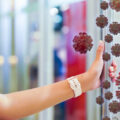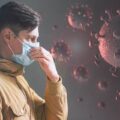The Indisputable Positive Impacts of Using Antimicrobial Coatings
Following the recent Coronavirus pandemic, the global market for long-term, semi-permanent antimicrobial coatings is expanding rapidly and with good reason! There is now a very compelling reason to assure microbial safety 24/7 in a multitude of settings ranging from hospitals, food factories, airports, train stations, offices and retail outlets. In this paper, we will provide an overview as to what actually constitutes an antimicrobial coating and why they have grown so significantly in their popularity.
Works Against Germs at the Molecular Level
Antimicrobial Coatings and Their Uses
Definition: Antimicrobial coatings may be defined as a semi-permanent surface coating that endows the surface to which it has been applied with broad-spectrum antimicrobial properties. As such these coatings will provide a long-lasting level of disinfection against moulds, yeasts, fungi, bacteria and viruses.
Uses: Antimicrobial coatings can effectively be applied to almost any surface whether a hard surface or the fabric of textiles.
Hard Surfaces: Antimicrobial coatings can provide effective protection against cross-contamination and infection in a wide range of applications. They can have the most significant infection control impact when applied to high-touch surfaces such as door handles, countertops, toilet and washroom facilities. Skilled application specialists are also able to successfully treat other high-touch surfaces such as ATM machines, lift buttons, intercom access keys, and biometric readers as the coatings are entirely compatible with all electrical devices, including those in hospitals and clinics.
Of course, the infection control benefits of using antimicrobial surface coatings in any clinical setting are profound and they have been proven to have a significant effect in the reduction of hospital-acquired infections with many medical facilities using them on their patient care equipment and devices. In addition to preventing the proliferation and transmission of pathogenic organisms via medical equipment and instruments, the use of residual antimicrobial coatings can also positively impact how healthcare facilities are routinely cleaned and disinfected in the future. For example, if medical high-touch surfaces are coated with a long-lasting antimicrobial coating, it makes the routine disinfection of these surfaces with harsh chemical disinfectants unnecessary, which in turn, increases efficiency, saves money and is environmentally friendly.
Another high impact area for antimicrobial surface coatings are in mechanical air handling units, HVAC ducting and ventilation panels, where their ability to control microbial transmission is a major benefit where management of internal air quality is a particular concern such as on commercial aircraft, trains, passenger liners or even large naval vessels.
Soft-furnishings, Textiles and Fabrics: The benefits of residual antimicrobial agents are not limited solely to hard surfaces as a coating, they can also be successfully used by impregnating fabrics, textiles and soft furnishings. Once again, the possibilities are almost endless!
In settings where infection control is of paramount importance the residual antimicrobial agent can be incorporated into the fabric of gloves, masks, uniforms, apparel, wiping cloths, towels, as well brooms, dust mops and brushes.
Where high volumes of potentially infectious travellers and commuters use buses, trains, ships or aircraft and their associated terminals and waiting areas, then seating and carpets can be treated. Not only will this effectively eliminate the risk of infectious disease transmission, but it will also prevent odours and mould growth.
| Not All Antimicrobial Coatings are Created Equal | ||||
|---|---|---|---|---|
| BRShield™ | Triclosan | Silver | Copper | |
| Effective antimicrobial formula | ✔ | ✔ | ✔ | ✔ |
| Non leaching formula | ✔ | |||
| Does NOT use poisons to kill microbes | ✔ | |||
| Does NOT promote adaptive organisms | ✔ | |||
| Safe for humans, pets and the environment | ✔ | Banned by the FDA in 2016 |
||
| NOT absorbed by micro-organisms and human | ✔ | |||
What are the Benefits of using Antimicrobial Coatings?
Long-lasting Protection Against All Forms of Microbial Life: Antimicrobial coatings have been empirically proven to provide residual long-lasting antimicrobial properties that can last for extended periods of time. In fact, on surfaces where abrasion and wear are minimal, their period of ongoing efficacy might be measured in years! Furthermore, because antimicrobial coatings destroy microorganisms physically, rather than chemically, then for as long as the coating actually remains physically present on the treated surfaces, its antimicrobial properties will remain active.
Cost-efficacy: In environments where thorough cleaning, sanitation and disinfection are of paramount importance and where the maintenance of hygienic conditions are a frequent, labour and material intensive process, then huge cost savings are likely to be made by opting for residual antimicrobial coatings instead. Instead of meticulously following onerous chemical disinfection protocols many times a day, instead, there is only a need to clean the surfaces on a routine basis to remove the build-up of any organic residues that will inhibit the antimicrobial properties of the surface coating.

Improved Cleanliness, Hygiene and Health: In high traffic, high footfall facilities, there is also the inevitability of a correspondingly high risk of surface contamination by individuals carrying and spreading pathogenic organisms from one place to another. Therefore, there is also a significant risk of these pathogens being transferred to other people by cross-contamination via these surfaces and they then become vehicles of infection and infectious disease transmission. Anywhere that has a regular flow of people transiting through it, such as hospitals, clinics, offices, markets, transit stations, shops or leisure facilities is also open to the risk its surfaces becoming infected.
In all these scenarios, long-lasting anti-microbial coatings can almost completely eliminate the risk of infectious disease transmission via contaminated surfaces as they can continue actively destroying pathogenic organisms, immediately on contact, on a 24/7 basis. Furthermore, once an antimicrobial coating has been applied to a surface, it causes no discolouration or any other adverse effects either on the appearance or the function of the treated surface.
Enhanced Infrastructure Value and Wellbeing: Buildings and facilities that have widely deployed persistent antimicrobial coatings on their hard and soft surfaces have consistently reported tangible improvements in the health and wellbeing of the building occupants. The use of antimicrobial coatings also adds value to a building as the associated risks of disease transmission have been appropriately mitigated. Therefore, as towns and cities become increasingly busier and the trend towards urbanisation continues, many building managers and organisations are employing the use of long-term antimicrobial coatings to preserve their hygiene and maintain a healthy environment for all their building occupants.
Related Posts
- One of Singapore’s Largest Retail Banks Chooses BR Shield to Protect its High Touch Surfaces
- The Silent Spreaders – Indirect Transmission
- Coronavirus: Covid-19 bug can persist in air for hours and on surfaces for days, study shows
- How Surface Coating Helps Reduce Germs in your Environment





